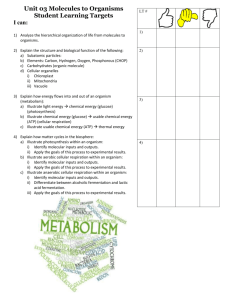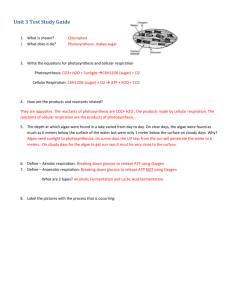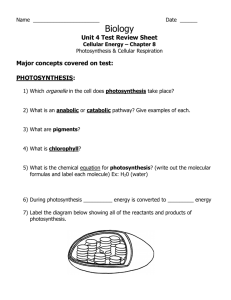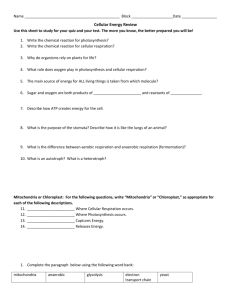9-1 and 9-3 PowerPoint Notes
advertisement
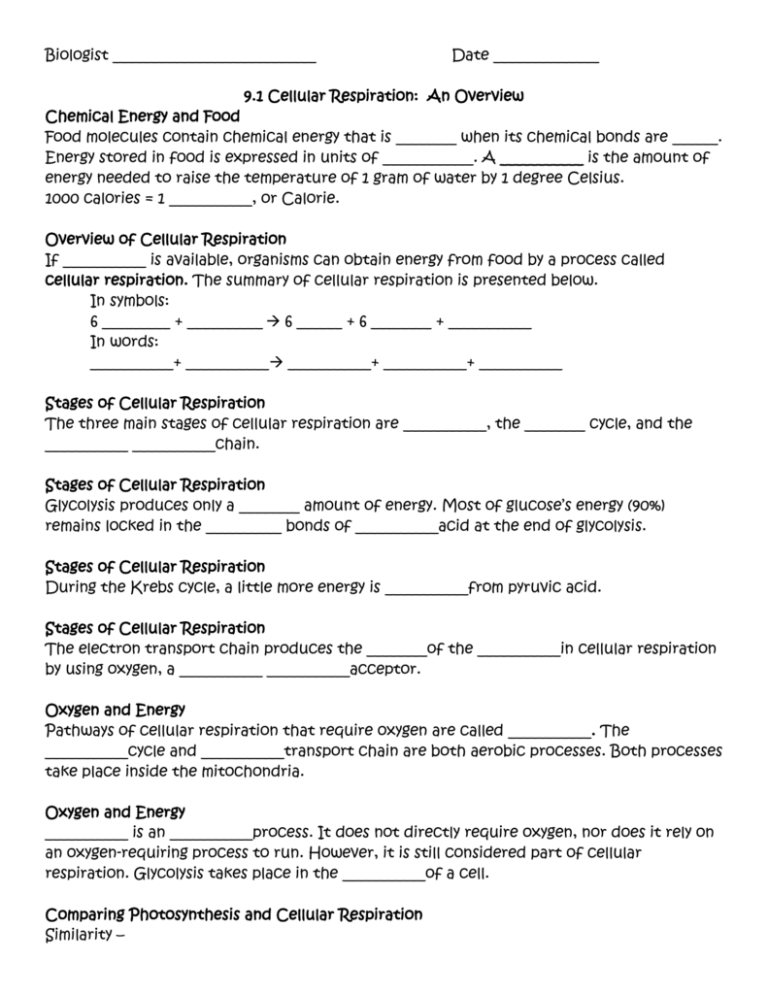
Biologist ___________________________ Date ______________ 9.1 Cellular Respiration: An Overview Chemical Energy and Food Food molecules contain chemical energy that is ________ when its chemical bonds are ______. Energy stored in food is expressed in units of ____________. A ___________ is the amount of energy needed to raise the temperature of 1 gram of water by 1 degree Celsius. 1000 calories = 1 ___________, or Calorie. Overview of Cellular Respiration If ___________ is available, organisms can obtain energy from food by a process called cellular respiration. The summary of cellular respiration is presented below. In symbols: 6 _________ + __________ 6 ______ + 6 ________ + ___________ In words: ___________+ ___________ ___________+ ___________+ ___________ Stages of Cellular Respiration The three main stages of cellular respiration are ___________, the ________ cycle, and the ___________ ___________chain. Stages of Cellular Respiration Glycolysis produces only a ________ amount of energy. Most of glucose’s energy (90%) remains locked in the __________ bonds of ___________acid at the end of glycolysis. Stages of Cellular Respiration During the Krebs cycle, a little more energy is ___________from pyruvic acid. Stages of Cellular Respiration The electron transport chain produces the ________of the ___________in cellular respiration by using oxygen, a ___________ ___________acceptor. Oxygen and Energy Pathways of cellular respiration that require oxygen are called ___________. The ___________cycle and ___________transport chain are both aerobic processes. Both processes take place inside the mitochondria. Oxygen and Energy ___________ is an ___________process. It does not directly require oxygen, nor does it rely on an oxygen-requiring process to run. However, it is still considered part of cellular respiration. Glycolysis takes place in the ___________of a cell. Comparing Photosynthesis and Cellular Respiration Similarity – Difference - 9-3 Fermentation Fermentation Fermentation is a process by which energy can be released from food molecules in the ___________ of ___________. Fermentation occurs in the ___________of cells. Alcoholic Fermentation __________ and a few other microorganisms use alcoholic fermentation that produces ethyl alcohol and carbon dioxide. Chemical Equation: ___________+ NADH ________ + _____ + ________ Lactic Acid Fermentation ______ organisms, including humans, carry out fermentation using a chemical reaction that converts pyruvic acid to lactic acid. Chemical equation: ___________+ NADH ___________+ _______ Energy and Exercise How does the body produce ATP during different stages of exercise? Quick Energy Cells normally contain ______ amounts of ATP produced during cellular respiration, enough for a few ________ of intense activity. ___________ ___________ can supply enough ATP to last about ____ seconds. However, extra oxygen is required to get rid of the lactic acid produced. Following intense exercise, a person will huff and puff for several minutes in order to pay back the built-up “___________” and ______ the ___________from the body. Long-Term Energy For ____________ exercise lasting longer than 90 seconds, ____________ _____________ is required to continue production of ATP. Cellular respiration releases energy more _________ than fermentation does. The body stores energy in the form of the carbohydrate __________. These glycogen stores are enough to last for ___ to ____ minutes of activity. After that, the body begins to break down other stored molecules, including _____, for energy.
